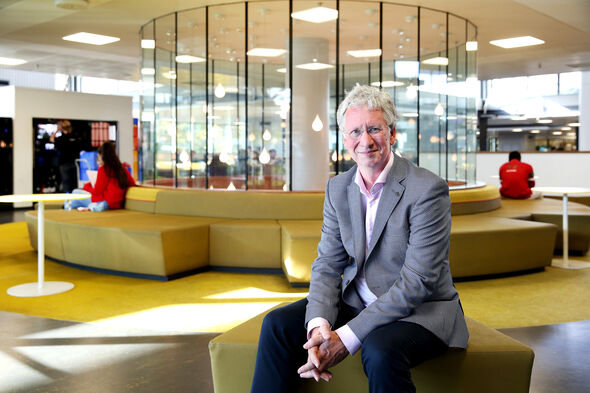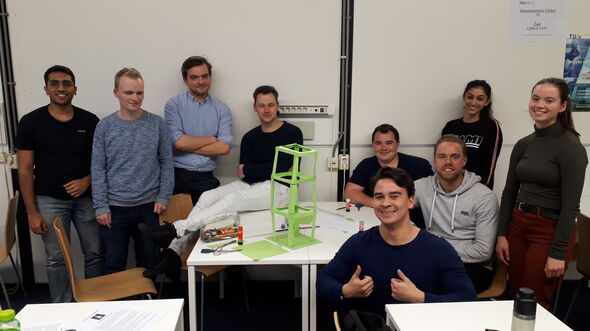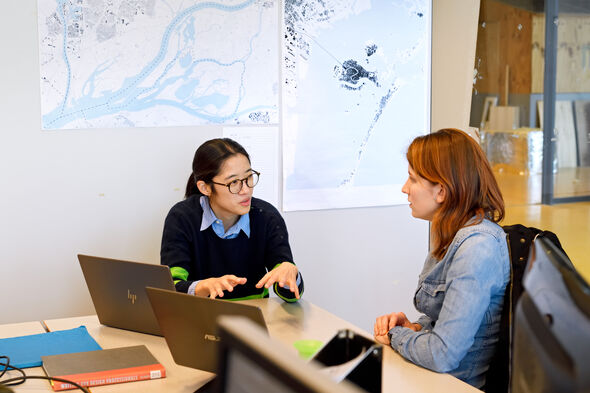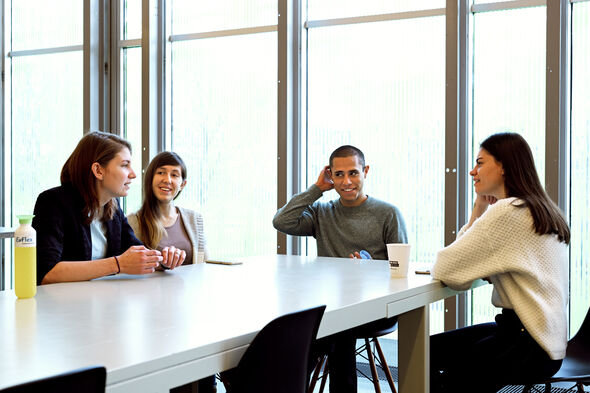
International classroom: what's in it for you?
It won't make quantum physics any easier to understand but by appreciating the diverse perspectives of various cultures you can develop more a more wide-ranging approach to problem-solving. Added to which, this is good preparation for moving in an international field of work. These are important arguments, says Paul Koenraad, Dean of the Graduate School, for working towards the 'international classroom' at TU/e. Fortunately, we don't need to start from scratch when realizing this TU/e plan.
Clearly feeling awkward, two students of Mechanical Engineering accept the kisses that are placed on their shoulders. They are the engineers - the other students are inhabitants of the fictional country of Derdia, whose customs include this practice. The Derdians are familiar with these customs, the engineers have to work them out for themselves. Their mission is to have the locals build a paper tower. This results in strange scenes, such as when the students join hands - Derdians love physical contact - or when one of the women students suddenly leaves the group because she is not allowed to sit with the men when they cut up paper. “Awkward,” responds one of the women engineers, shaking her head when she first sees this happen.
This role play, in which the participants succeed in building a tower, is followed by some explanation given by lecturer Vincent Merk. He is a member of the TU/e service Education and Student Affairs and he regularly gives this kind of training. On this occasion he is giving Intercultural Teamwork training to students on the Teamwork & Academic Writing course at Mechanical Engineering. He tells his students how they can draw various lessons from the role play. “Be prepared when you go to another country, and have an open and flexible attitude. Adapt, but don't lose sight of yourself. See the world beyond yourself, don't fall into the trap of stereotyping and step outside your comfort zone.” And, last but not least, “It takes two to tango.” As the aims of training of this kind, he cites, ‘getting a feel for other cultures,’ ‘being able to explain technologies well’ and ‘better teamworking ability’.
Immersed in their culture
Master's student Marnix van der Linden recalls the training he completed a few weeks ago. “I realized I was so focused on the aim of building a tower, that I completely failed to appreciate that I had come to their country, was immersed in their culture. It taught me to focus less on the task and more on the people, partly because at the end of the day this is the most efficient way and the friendliest way to reach your goal.”
In his DBL group he was collaborating with a couple of Dutch students as well as with an Indian student. “This was actually the first time that I had come into contact with another culture in a ‘professional’ context. As a tourist, your attitude is always one of curiosity, but in your work or academic study that's not automatically the case. It can be difficult to collaborate with a student who is used to another culture, but it can be enriching. This was the case and I found the collaboration very positive. There were certainly some cultural differences - but only in an enjoyable, funny and positive way.”
Overview of the training courses
The Career & Professional Skills department at Education and Student Affairs gives various training courses designed to build cooperation between various cultures:
• Within the master's at Mechanical Engineering: ‘Intercultural Teamwork’ as a part of the course on Teamwork & Academic Writing.
• On the master's at Electrical Engineering and Mechanical Engineering: ‘Intercultural Teamwork’ within the Professional Skills series on the master's course Systems & Control.
• On the master's offered at Built Environment: ‘Group Dynamics’ on the Collaborative Design course.
• On PDEng programs: ‘Intercultural Communication & Cooperation’ or workshops on Communication Skills on the Professional Development pathway.
• On PROOF (for PhD students): the ‘Cross Cultural Effectiveness’ workshop as part of the PhD/PDEng Kick-off Event.
On the bachelor's courses many professional skills with international relevance are taught, but these skills are not flagged up as being 'international'. Now and then Vincent Merk (or one of his colleagues) runs a special session on internationalization when teaching these skills.
There is certainly scope for running training courses of this kind more often at TU/e - depending on the measures taken at the university to create an 'international classroom'. A policy plan, written and approved last year, points the way forward. This plan includes an answer to the question of what the 'international classroom' at TU/e involves.
The definition of the international classroom is (paraphrased) as follows: ‘the learning space of a group ofstudents in which:
* different nationalities with different cultures are represented;
* education is delivered in English;
* both students and staff participate in multicultural teams and appreciate diversity;
* the diverse learning environment is such that it enables students to gain international and multicultural experience and the quality of the education is improved.’

Paul Koenraad (Dean of the Graduate school) and policy advisor Lisette Appelo wrote the plan. According to them, TU/e won't have to start from scratch in its efforts to create the international classroom. Koenraad says, “Plenty of initiatives in this area already exist, but we need to create a comprehensive overview of them, decide what we should and shouldn't do, and learn from best practice. Mixing different nationalities is not, for example, that we per se need to do, but we should consider when it's appropriate to do so and when not. And we could train lecturers to benefit from the presence of different nationalities.”
As to the why behind the international classroom, Koenraad says, “Bringing different nationalities together in the learning environment isn't going to help you understand quantum physics any better, but their different perspectives can give you more a more wide-ranging approach to problem-solving. What's more, the international classroom prepares you for professional practice, which is becoming increasingly international. World travel is going to play an ever bigger role in people's careers.”
According to Koenraad and Appelo, the lecture theater is not the only place the international classroom will be realized, it will go further. Appelo, “Sport and study associations, for example, have an important role to play. And we must enable our Dutch students to gain experience abroad and show our foreign students the Dutch culture.”
Digital toolbox for lecturers
Inge Adriaans, TU/e policy officer with International Affairs, is currently working up the action plan to achieve the various policy aims. Pilot projects at various TU/e services and departments will be an important aspect of the implementation.
One of these projects could be the adoption of a digital toolbox for lecturers. Vincent Merk says, “In our 4TU context, we have developed a toolbox for internationalization, taking the international classroom as a major theme. We intend to give lecturers preparation tips and teach them how they can get the best out of their international class of students.”
Collaboration between different nationalities cannot yet be taken for granted throughout TU/e. Logically speaking, it is also a question of numbers; on programs with more international students, students collaborate more often with different nationalities.
To find out the kind of advantages - and possibly disadvantages - an international classroom can bring, we followed a group of master's students at Built Environment. They are working on a project that lasts two semesters and during the first semester they often worked as a group and in smaller teams. A group excursion to Venice to explore the city's water problems brought the group closer together. How are some of these students of various nationalities finding the collaboration?
"It teaches you other ways of thinking"
Taiwanese student Jou-Fang Wang: “It is difficult to say whether the differences between us arise from our personalities or culture. Either way, I think our generation has a global attitude. Sometimes someone has a different way of thinking, or the difference lies in the soft skills. To me, these seem like details and this exposure teaches you other ways of thinking. For example, personally, I prefer to play it safe, and prefer not to rush in and work out everything in detail. Now I have learned that if you do work at the detailed level you'll get there too. I see it as an opportunity to learn something new.”
"The language barrier took some getting used to"
The Dutch Katja Heidweiller says: “Before this I had worked little with internationals during my studies here. But I had been abroad for my program and encountered another culture in that way. The language barrier took some getting used to; it means you sometimes miss information. There were three of us Dutch students and we deliberately joined three different groups because the documents from the municipality and other policy memoranda were in Dutch. The Dutch words for 'ditch' and 'river' are sometimes difficult for non-Dutch speakers. But sometimes the differences were funny. We've laughed about our different food customs and the lack of sunshine here. I think it would be good if our department made more use of peer reviewing, then you can talk more easily about what could have gone better.”
"I would have liked to have known more about the Dutch and their customs beforehand"
Gokce Gemalmaz from Turkey had some experience of group work, "though at TU/e I'm working in groups more than I ever have before. This graduation component is my first experience of working with so many different nationalities, but now I prefer it. We've certainly noticed some differences between us.
The Dutch are sometimes more direct and think along a particular line whereas other nationalities are more likely to consider multiple possibilities and keep them as open as options. Some nationalities are a little more used to thinking in concepts, such as the Italians. Others are more technical by nature, such as the Dutch. But there's no question of one way being good and the other not. I would have liked to have known more about the Dutch and their customs beforehand. Within the project group we talk about all our differences fairly often. But the number one topic is definitely food.”
"There are always some bumps in the road"
Iva Novoselska from Bulgaria: “I see the differences mainly in the use of different methodologies. That other students are used, for instance, to using other software to produce drawings. Sometimes you don't fully understand each other, but that's also part of the process. At the end of the day, everyone wants to learn and achieve the same aim. There are always some bumps in the road. It's taught me a lot. Our assignment was about water and I didn't know it was so important in the Netherlands. The only difficulty was trying to set up meetings together. Many internationals are taking more courses than the Dutch students, and have a busier schedule.”
"I had to get used to planning"
Mexican David Villegas: “I had to get used to planning, an approach that you see here and in other northern European countries. In the more southerly countries, people are generally more flexible about their planning. But after a while I could see it had benefits. Besides, I feel I should adapt to the customs here. Being friendly and open will get you a long way anywhere in the world. It is nice that the group is becoming closer all the time; we tease one another in a playful way. I would have liked it better if I had known more about the Netherlands and Dutch customs in advance. The Dutch are very relaxed about other cultures, that's my own experience anyway.”




Discussion